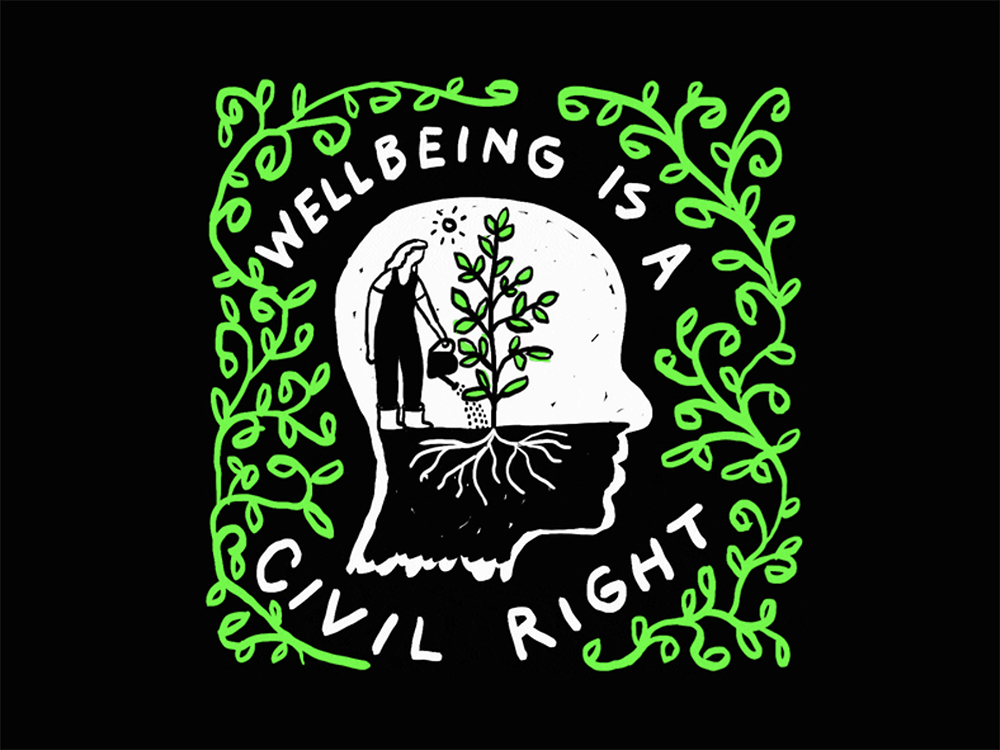
There is no denying that over the last three years our world has been fundamentally reshaped by a worldwide pandemic, urgent climate collapse, widening inequality, rising authoritarian threats, and increasingly violent reactionary culture backlash. The peril of this moment is defined by precarity of many of the systems, norms, and order that we have known. It is an inherently stressful time. The fact is that as our world has been reshaped, we—as people—have been, too.
And we have to be honest about the toll. The conditions through which we live require a lot from us and many of us have been in a constant change cycle that affects the minutiae of our day-to-day routines.
Philanthropy, as well as other service-based work, place even more demands on our strained capacity. Plenty of data reveal increased stress levels on nonprofits since the pandemic. Yet, we have to assume high stress levels, compassion fatigue, and burnout are mirrored for funders as well. A 2019 UK survey found that 80 percent of charity workers experienced workplace stress, and a staggering 42 percent reported that their job was not good for their mental health.
Sharp shifts in funding priorities is one key source of this heightened stress because it entails major changes: updating policies, systems, and other apparatuses to make these shifts, gaining staff and board consensus to make changes within traditionally slow-moving institutions, administering funds so that grantees quickly receive funds in response to urgent, evolving needs. Some philanthropic staff have felt a two-sided squeeze—internally and externally—on one end, pressure to support grantees in crisis during twin pandemics, and on the other end, lethargic or bureaucratic responses to quickly deliver necessary changes.
The result is a deeply unwell sector that is struggling to admit its own challenges in the name of service.
Fortunately, more funders are recognizing the internal costs of these times, and more people are no longer in denial about their well-being in the sector. A closer look at the following four areas can further improve your well-being as we continue to live through a time of deep change.
1. Address burnout at its source. Burnout is defined as emotional exhaustion and negative attitudes toward one’s job. Its characteristics range from physical manifestations to diagnosable mental health concerns. The American Psychological Association attributes burnout to more than just a heavy workload. Other factors contributing to burnout include a lack of control over what one does and when one does it; the absence of meaningful rewards; few connections or lack of social support; sense of unfairness exhibited by superiors; and a significant incongruence of values.
Burnout, from this perspective, offers an opportunity to examine the core of your dissatisfaction. More often, burnout is much more than merely a work-life imbalance. Rather, it is a compound set of factors that distance a person from their own agency, purpose, beliefs, and without strong support or relationships in their work. Essentially, it strips a role from its humanness. It is not that your role, even in philanthropy, must be your raison d’être; however, it does mean that your connection cannot be chronically and substantially overridden by increased pressure, and responsibility.
As you reflect on whether you are burned out or which stage of burnout you are at, be honest about where you are, hold self-compassion for the impossibility of our modern-life demands, and identify imbalances in each burnout factor to create a recovery plan in which you enlist support and accountability from appropriate counterparts (e.g. supervisor, mentor, human resources, life partner, trusted friends). This recovery plan should recognize that taking a few vacation days is not enough. You are investing in a strategic, holistic intervention that you need to re-center.
2. Treat Stress Seriously. Stress is normalized in our professional lives, especially in the United States. A majority of workers are nearly maxed out on their stress levels most of the time, particularly around difficulty of their work and due to long hours. Worsened by the pandemic, the Centers for Disease Control issued guidance to employers about high-stress signs and stress management. Stress can be pervasive and part and parcel of an overwork culture, and still very damaging to us long-term.
Increasingly, we are learning—empirically and anecdotally—about the serious costs of stress. High stress is linked to health problems like heart disease and diabetes. Sustained stress, the kind caused by unrelenting work environments, puts our bodies in continued state of activation for which they are not equipped. Gabor Maté, a well-known palliative doctor and author, outlines an even more startling response in his book, When The Body Says No: Understanding the Stress-Disease Connection”The fundamental problem is not the external stress… but an environmentally conditioned helplessness that permits neither of the normal responses of fight or flight. The resulting internal stress becomes repressed and therefore invisible.”
Ultimately, he describes that our stress responses can be so dysregulated that we can lose our ability to respond to stress, which later proves debilitating to our brains, bodies, and emotions. His book details the ways in which the mind-body connection can be irreversibly impacted by stress, and how seriously we must treat stress and its underlying trauma—including surviving a worldwide pandemic.
His primary advice to treat stress might feel counterintuitive: let yourself feel your feelings. Maté emphasizes that the more we constrict our emotions, the more we will feel stressed out, lonely, and hurt. Specifically he says that, after traumatic events, a tendency to constrict leads to heightened fear, defensiveness, aggression, and chronic pain. In other words, our natural responses do not go away because they ignore them, they simply manifest in potentially more harmful ways. Therefore, to take stress seriously, we need to prioritize safe places to deposit and process our feelings, whether that is a journaling practice, crying in the shower, talking to a therapist, or anything else that allows you to feel fully.
3. Tend to grief. Although grief—a natural response to loss—underlies our formative emotional experiences of change, it is seldom tended to outside the context of a death. There actually are at least 12 major life events that can cause grief, and other more subtle losses that can trigger a grief response. Major changes can shift our identities too, even if our loss feels positive. Looking back on the last two years’ changes and losses, your grief inventory might be larger than you realize.
Grief, in its wide constellation of emotions, is present with us at work in several ways. First, we can carry grief from our lives into our work because, in reality, we inhibit the same bodies when we clock in as when we clock out. Second, grief can be an effect of sudden changes in either how we see ourselves in our work (e.g., leading during a crisis) or the nature of our work (e.g., becoming a rapid responder as a funder). Third, when our work lives transform, we can feel the loss of a familiar routine that instills stability or grieve how we were able to work before things changed (e.g., missing spontaneous in-person interactions or the ability to work with reliable, continuous childcare). Another important way grief can surface for funders is facing the events or trends that your grantees are responding to. From the devastating exposure of health-care disparities revealed by COVID-19 to systemic racism made evident through the loss of lives, the people who power funding institutions might grieve the conditions their organizations are seeking to change. Altogether, grief is all around us in this period of deep change.
Similar to stress management, grief requires our gentle attention. Importantly, it needs outlets, especially through the body, to healthily integrate us into our new realities. Body-based grief practices offer an emotional anchor, and, as some death workers believe, the ability to resiliently weather life’s most difficult situations. Grief, in its full expression and release, extends to us a chance to be more authentic. Consider the parts of you that have been touched by grief the last few years, large and small; make an effort to communicate more to others about the loss that you feel; and engage in meditation, movement, and other somatic activities to intentionally grief-tend.
4. Be willing to change your support. As you are changed by our times, what you need will change, too. I often observe, in my role as a healer, that people are in the midst of tremendous transition but never reassess their support system. Sometimes denial is a reason why people refuse to shift their support because they want to believe that what they had in place will be effective. Other times, people are too depleted to tune into what they need, much less make even more changes. It is common, too, that a different support system does not even occur to people in a flurry of life or that it is necessary. But, it really can make all the difference to at least examine your support.
You can ask yourself three questions about your support system—the people, practices, and resources that help you manage your life and meet your needs and goals.
- Is your support system agile enough? You need to feel that your supports are responsive to the pace, cadence, or rhythm of your life and are flexible as your life changes.
- Is your support system robust enough? Your supports need to be able to hold the depth of your needs and emotions.
- Is your support system trustworthy enough? Your supports should make you feel like you can be vulnerable with them and that they can receive your most authentic feelings and experiences.
It is not so much that each part of your support system needs to meet all three criteria, however, if your support system is inadequate in any of these areas, it is worth making revisions or additions so that your system as a whole can meet your needs.
One other consideration, which I illustrate through a support temperature worksheet, is rating your support system’s capacity and whether the people in that system have enough capacity to provide meaningful support?. The first two questions about your support system agility and depth gets into capacity, in part; and, capacity asks whether people are available enough, with the quality of presence, and skills that you need, for support. Unless your answer is yes, it is important to make a shift.
Improving your well-being in these four areas can be transformative, particularly if you adopt a holistic, body-based approach prioritizing your feelings and your support system. At the same time, individual efforts only go as far as our environments and conditions allow. Along with your individual changes, it is critical to contribute to a culture of care at your organization. Encourage others in their well-being decisions; model well-being practices for others; and support institutional changes that promote well-being. As Edgar Villanueva reminds us, if we shift philanthropy toward mutual sharing and community instead of transactions, not only are we repairing the sector, we are leading change from within.



